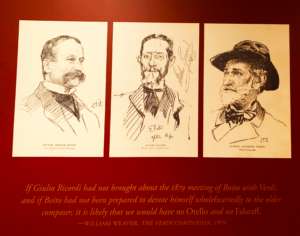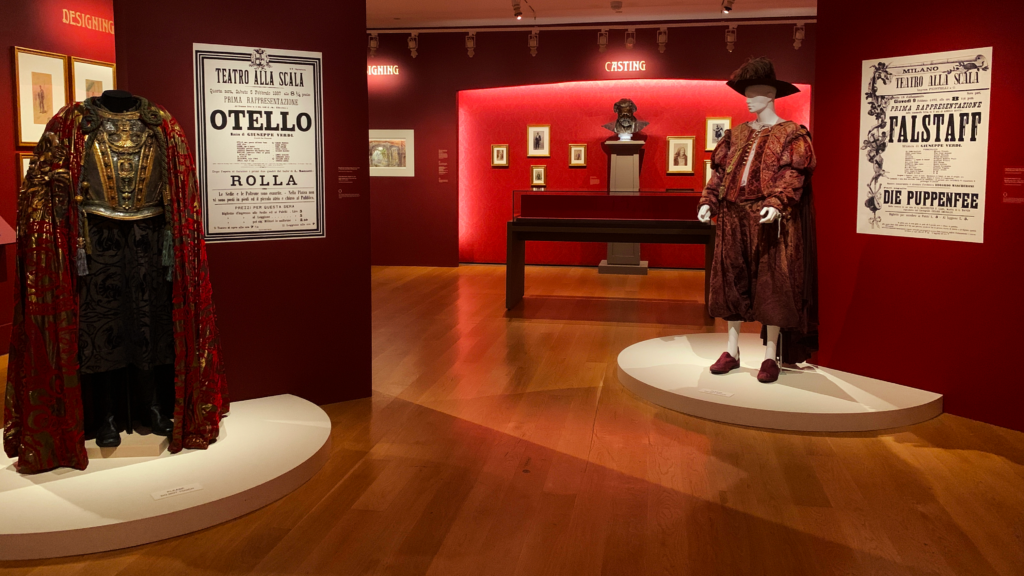
Moment In Time – Exploring The Creation Of Verdi’s ‘Otello’ & ‘Falstaff’ At The Morgan Library & Museum
By David SalazarSince Sept. 6, 2019, the Morgan Library & Museum in New York City has been holding an exhibition that details the development and creation of Verdi’s final two operas.
The exhibition, entitled “Verdi: Creating ‘Otello’ and ‘Falstaff’” and curated by Gabriele Dotto, presents a wide range of materials courtesy of the Bertelsmann-owned Ricordi Archive, all organized as to give the viewer an opportunity to better understand the process that the famed composer undertook in creating the work.
Entering the lone salon, you see a massive portrait of Verdi standing in front of two folios of Shakespeare’s texts, both opened to pages from “Otello” and “Falstaff.” To the right, a television screen depicts scenes from “Otello” across a wide range of recordings including the Royal Opera House’s “Otello” with Jonas Kaufmann and Maria Agresta as well as the Met Opera’s “Falstaff” with Ambrogio Maestri.
One is expected to start the journey on left side of the room and circle around to the right side of the exhibit with the first section focused on the commissioning of the work. Here viewers can find a series of letters in which Verdi’s cohorts, Riccordi and Arrigo Boito try and convince the retired master to return to composition. There is also a letter from his wife Giuseppina Strepponi to Ricordi’s wife Giuditta in which she talks about having received an infamous cake of “Otello.”
Perhaps the most fascinating section of the exhibit comes next, with contracts that summarize that Verdi was paid 200 lira for the score of “Otello” (presumably about $1 million in today’s money) as we all as how Verdi managed to retain close to 50 percent commission on purchases of the libretto and rentals and purchases of the score of “Otello,” while taking a considerably lessened percentage for “Falstaff;” as was explained to OperaWire during our visit, comedies were perceived as being of lesser value due to lessened demand. Also worth mentioning is that Verdi did not sign the contracts for “Otello” until the night before the premiere, retaining the power of whether the work itself even got a chance to see the light of day.

From there, viewers move on to the artistic aspects of the exhibition with designs for the initial sets and costumes for both works, many of which include specific instructions on the back as to how to execute characters, etc. At the center of the backwall of the exhibition is a famous bust of Verdi by Vincezo Gemito, looking over the entire room. Laid out in front of this sculpture is a production book for “Otello” in which Verdi himself wrote out precise stage directions for the work; even though most modern stage directors are unlikely to even look at this book, it allows a unique perspective on how the composer himself conceived his own opera.
Moving onto the right side of the room, audiences can now see the published scores with an engraved plate for the first page of “Falstaff.” A nearby video showcased the painstaking process of printing pages back in the time with a case of punches used by engravers at Casa Riccordi hanging inside a nearby case; for those who have no idea how printing was once executed, this part of the exhibition might prove the most illuminating. Moving along the wall yields printed scores, including some special editions. There are also two production cards that list the printings of librettos for both operas, offering more insight into Ricordi’s own bookkeeping.
At another part of the exhibition, audiences can get a chance to check out the final fugue from “Falstaff” across three different interpretations with an interactive score projected onscreen before them, while the center of the room features prominent costumes from two recent productions of the famed operas. There are also paintings by Stephanoff and Delacroix
The exhibit eventually ends with the video clips from the two works, giving viewers an opportunity to come full circle with greater knowledge into the intricacies and behind the scenes of two of the greatest operas of all time.
Those who know the histories of both works extensively might not find much to discover, though there is undeniably a sense of wonder when you take a glance at documents that were once held and created firsthand by one of the most iconic composers to ever live. But those who are still grounding themselves in these two works will find a lot to take away from an exhibit that gives a lot without overwhelming you. It is likely best to take the tour with the audio aid or a guide, in order to contextualize what exactly you are viewing, especially with regards to the contracts and printing process.
“Verdi: Creating ‘Otello’ and ‘Falstaff’” runs Jan. 5, 2020.
Categories
Special Features

